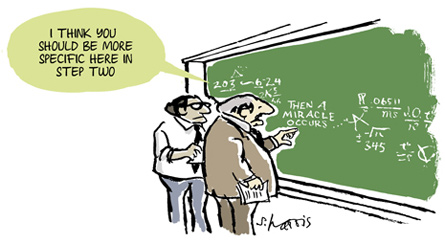To sell or to science?
Re-thinking manuscript structures and the importance of selling your story.

Today’s practice of evaluating the quality of a scientist by h-index has led to an ever-increasing pressure on scientists to publish results in high-ranking journals. Simultaneously, driven by the desire to extend the outreach to an interdisciplinary and non-scientific audience, several of these high-ranking journals favor articles with appealing titles, introductions and discussions, while exiling methods and in-depth result sections to the end of the article, into supplementary information or visually diminishing their importance by printing them in smaller text size. This current system requests both authors and reviewers to invest enormous amounts of time in creating and reviewing redundant information in the form of long introductions and discussions, that ultimately are (partly) subjective. Being non-anonymous and based on an author’s past publication and citation number, it creates a publication bias towards few, prestigious workgroups and nationalities that crucially impact the direction of future research. Even worse, it turns scientific communication into a market-based system: What gets published well, is what is sold well and comes from an authorized vendor.
Publication systems are the primary determinants of how scientific results are circulated and interpreted and strongly impact scientific focus areas. Considering the accelerating global humanitarian and ecological crises that require meaningful and powerful solutions to be found, we need to develop a novel, time- and money-efficient system that enhances scientific transparency, equality and accessibility. I suggest a double-blind review process combined with a shift in manuscript structure and provision to reach the above-mentioned goals.
First, the common single-blind peer-review system by which reviewers stay anonymous while authors’ names and institutions are boldly printed on the first page of a submission is often regarded to be the gold-standard of scientific assessment, while in fact, it leaves plenty of space for gender, nationality and prestige bias in publication number and rate. Even a single glance at the author list may (un-)consciously determine an editor’s or reviewer’s evaluation of an article. Faster, more numerous and higher-ranking publications of already established authors due to unequal evaluation will create inequality in career development among individual scientists. Even worse, it may lead to the development of an artificial scientific monopoly, in which single workgroups may dominate the scientific literature on a topic and via feedback mechanisms (e.g. referencing in funding proposals) ultimately determine the direction of future science. Thus, all scientific journals should be urged to implement a double-blind peer-review system to enhance the quality and equality of published research and enable holistic scientific approaches.
A second and more long-term change regards manuscript structures that should allow authors and readers to focus on novel science, expressed in the hypothesis, methods and results, rather than having to spend time on scientific story-telling. The steadily increasing number of published articles, and the need to re-invent the theoretical wheel behind their research question, i.e. summarizing existing knowledge to provide the requested introduction that in a very similar way exists dozens of times (for most research fields), leaves scientists with enormous amounts of time spend on both writing and revision of their own articles and reviewing other articles. Certainly, a scientific article should bridge the gap between different focus groups and non-expert readers should be able to understand the conceptual background of the research. Yet, for another large group, i.e. expert scientists in the field, theoretical background information is redundant. Moreover, the overrepresentation of introduction and discussion in some journals introduces the risk of calling the reader’s attention to subjective interpretation rather than objective information. Making better use of existing of web-based data hubs could meet the dual challenge of reducing the time and effort spend in publishing, while enhancing transparency, objectivity and user-friendly accessibility of information. I suggest the implementation of an interlinked system of three main datahubs.
A) Background information will be stored in a web encyclopedia that presents a unified knowledge base and reference system. Instead of writing an introduction, an author will create a list of keywords (much like those currently used to find articles in web searches), including theories and concepts, that link back to a web encyclopedia. By deciding which keywords to click on a user can determine which introductory information to the topic he/ she needs to understand the article, an expert reader can skip that information and go ahead to the actual science: hypotheses, material and methods and results.
B) A second datahub will contain protocols for standardized research methodologies to create globally comparable data. While describing their methodologies in depth in their manuscripts, authors may still be able to link back to that system. This would create an attempt to standardize global research methods and thus reduce the amount of money, time, and work force wasted in non-comparable research that we can only speculate about the causalities for different results in different studies.
C) Finally, a unified data repository providing the reader with easily accessible raw data and scripts of the statistical analyses performed. While such repositories do exist already, we should centralize raw data storage as much as possible, and certainly for specific research fields.
Future manuscripts would consist of a title, keywords (linked to A), hypotheses, material and methods (linked to B), results (linked to C) and a short discussion of the implications of this research (linked to A if necessary).
Certainly, the installment of a web-referenced system will require a large interdisciplinary effort, with expert scientists creating an adjustable but peer-reviewed system of encyclopedias. Yet, peer-reviewing a small number of articles that relate to the main hypotheses and concepts behind a scientific field will overall require less work than the constant reviewing of ever-increasing amounts of manuscripts that redundantly repeat information but require careful proof-reading.
Combined, changing manuscript structures and assessing them in a double-blind review will reduce workload, enable user-friendly open access to the level of information needed, and enhance scientific objectivity, equality and quality.



